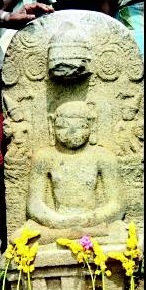Chennai: Rajiv Gandhi Salai
This is a collection of articles archived for the excellence of their content. |
Sculpture of Lord Mahavira
D Madhavan
The Times of India, Sep 1, 2011
Padur on Old Mamallapuram Road or Rajiv Gandhi Salai
1,000-yr-old sculpture now a washing stone
For decades, women used a stone near the temple tank in Padur on Rajiv Gandhi Salai or Old Mamallapuram Road to wash clothes. Village elders and panchayat officials, who were renovating the tank, turned the stone over only to discover that it was a rare Jain sculpture dating back more than 1,000 years. Now, the same women worship what was their washing stone and lay flowers on it.
Panchayat officials were clearing bushes near the tank and dug up the stone to shift it. They realized that the side women were using was the back of the sculpture and the front had got buried a few feet. “For years, we thought the sculpture was missing. We were overjoyed to find it,” said Padur panchayat president T Paramasivam.
The sculpture was of Mahavira, the 24th and the last Jaina tirthankara. The tirthankara is depicted in the ‘dhyana’ (meditation) pose with fly-whisk bearers behind him. The sculpture also has an ‘Ashoka vriksha’ (tree) above the head and ‘chamaradharis’ (bearers carrying flowers) on each side. Only the first and 24th tirthankaras — Rishabha and Mahavira — are depicted in sculptures and worshipped.
Archaeologists said the presence of three umbrellas above the head was a clear indication that the sculpture was that of a Jain tirthankara and not the Buddha. “Sculptures of Jain tirthankaras, including Mahavira, are bare bodied whereas those of the Buddha are always shown as covered with a piece of cloth,” said former deputy superintending archaeologist of the state archaeological department K Sridharan.
The Government Museum in Egmore is yet to retrieve the sculpture, which is slightly damaged, but the villagers have said they plan to build a temple for it.
Archaeologists said Chennai and adjoining districts, like Kancheepuram, were important centres of Jainism till the 10 th century CE, especially during the later Chola period.
While cleaning a tank, panchayat officials in TN found that the stone used for decades to wash clothes was the back of a sculpture that was believed to have been lost
